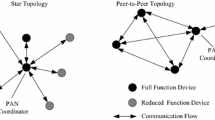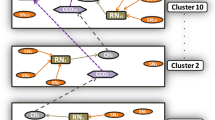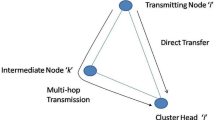Abstract
Wireless Body Area Networks(WBANs) is one of the most attractive communication technologies in recent years. Herein, network lifetime acts as a key factor in various WBANs applications. In this paper, an adaptive energy-aware relay mechanism is proposed to improve the network lifetime performance of WBANs based on the framework specified in IEEE 802.15.6 protocol. The proposed mechanism considers the energy-level of each node in the network to adaptively adjust the topology of the network in order to conserve the nodes which are lack of energy. The mechanism consists of two stages which are initialization phase and update phase. The update phase in the mechanism can be invoked by either enquiry method or report method to efficiently make relay selection for the network and reform the topology according to the varying network conditions. As a consequence, WBANs can make full use of residual energy in the network to improve the lifetime of WBANs. The simulation results show that the proposed mechanism can effectively prolong the network lifetime comparing with the original star topology strategy and other relay mechanisms proposed for WBANs. In addition, a scenario is designed where a sensor node in the network has the ability of moving to illustrate the capability of our mechanism to support mobility of sensor nodes.















Similar content being viewed by others
References
Chen, M., Gonzalez, S., Vasilakos, A., Cao, H., & Leung, V. C. (2011). Body area networks: A survey. Journal Mobile Networks and Applications, 16, 171–193.
Cavallari, R., Martelli, F., Rosini, R., Buratti, C., & Verdone, R. (2014). A survey on wireless body area networks: Technologies and design challenges. IEEE Communications Surveys and Tutorials, 16(3), 1635–1657.
IEEE. (2012). IEEE standard for local and metropolitan area networks—Part 15.6: Wireless body area networks (pp. 1–271).
Di Franco, F., Tinnirello, I., & Ge, Y. (2014). 1 Hop or 2 Hops: Topology analysis in body area network. In Proceedings of IEEE EuCNC (pp. 1–5).
Naganawa, J., Wangchuk, K., Kim, M., Aoyagi, T., & Takada, J. (2015). Simulation-based scenario-specific channel modeling for WBAN cooperative transmission schemes. IEEE Journal of Biomedical and Health Informatics, 19(2), 559–570.
Abbasi, U. F., Awang, A., & Hamid, N. H. (2013). Performance investigation of opportunistic routing using log-normal and IEEE 802.15.6 CM 3A Path Loss Models in WBANs. In Proceedings of IEEE MICC (pp. 325–329).
Smith, D. B., Miniutti, D., Lamahewa, T. A., & Hanlen, L. W. (2013). Propagation models for body-area networks: A survey and new outlook. IEEE Antennas and Propagation Magzine, 55(5), 97–117.
Zhang, Y., Zhang, B., & Zhang, S. (2017). A lifetime maximization relay selection scheme in wireless body area networks. Sensors, 17(6), 1267. 1-20.
Youssef, M., Younis, M., & Arisha, K. A. (2002). A constrained shortest-path energy-aware routing algorithm for wireless sensor networks. In Proceedings of IEEE WCNC (pp. 794–799).
Haibo, Z., & Hong, S. (2009). Balancing energy consumption to maximize network lifetime in data gathering sensor networks. IEEE Transactions Parallel and Distributed Systems, 20(10), 1526–1539.
Yasaman, K., Rashid, A., & Ashfaq, K. (2013). Energy efficient decentralized detection based on bit-optimal multi-hop transmission in one-dimensional wireless sensor networks. In Proceedings of IEEE WD (pp. 1–8).
Khoa, T. P., Duy, H. N. N., & Tho, L. (2009) . Joint power allocation and relay selection in cooperative networks. In Proceedings of IEEE GLOBECOM (pp. 1–5).
Lin, C.-S., & Chuang, P.-J. (2013). Energy-efficient two-hop extension protocol for wireless body area networks. IET Wireless Sensor Systems, 3(1), 37–56.
Pan, R., Chua, D., Pathmasuntharam, J. S., & Yong Ping, X. (2015). An opportunistic relay protocol with dynamic scheduling in wireless body area sensor network. IEEE Sensors Journal, 15(7), 3743–3750.
Chai, R., Wang, P., Huang, Z., & Su, C. (2014). Network lifetime maximization based joint resource optimization for wireless body area networks. In Proceedings of IEEE PIMRC (pp. 1088–1092).
Elias, J. (2014). Optimal design of energy-efficient and cost-effective wireless body area networks. Ad Hoc Networks, 13(1), 560–574.
Aravind, M.T., & Jacob, L. (2018). Energy efficient and reliable communication in IEEE 802.15.6 IR-UWB WBAN. In Proceedings of the 2018 international conference on advances in computing, communications and informatics (ICACCI) (pp. 2352–2358).
Ding, J., Eryk, D., Huang, X., & Fang, G. (2013). Energy-efficient cooperative relay selection for UWB based body area networks. In Proceedigs of the IEEE ICUWB (pp. 97–102).
Moosavi, H., & Bui, F. M. (2016). Optimal relay selection and power control with quality-of-service provision in wireless body area networks. IEEE Transactions of Wireless Communication, 15(8), 5497–5510.
Liao, Y., Leeson, M. S., Cai, Q., Ai, Q., & Liu, Q. (2018). Mutual-information-based incremental relaying communications for wireless biomedical implant systems. Sensors, 18(2), 515.
Choudhary, A., Nizamuddin, M., Zadoo, M., & Sachan, V. K. (2020). Multi-objective optimization framework complying IEEE 802.15.6 communication standards for wireless body area networks. Wireless Networks, 26, 4339–4362.
Huque, Md. T. I. ul., Munasinghe, K. S., & Jamalipour, A. (2014). A probabilistic energy-aware routing protocol for wireless body area networks. In Proceedings of the IEEE VTC-fall (pp. 1–5).
Tsouri, G. R., Prieto, A., & Argade, N. (2012). On increasing network lifetime in body area networks using global routing with energy consumption balancing. Sensors, 12(10), 13088–13108.
Gomathi, C., & Santhiyakumari, N. (2016). OFSR : An optimized fuzzy based swarm routing for wireless body area networks. In Proceedings of the SPIN (pp. 507–512).
Kim, D. Y., Kim, Y., Cho, J., & Lee, B. (2010). EAR: An environment-adaptive routing algorithm for WBANs. In Proceedings of the IEEE ISMICT.
Huque, Md. T. I. ul., Munasinghe, K. S., Abolhasan, M., & Abbas, J. (2013). EAR-BAN: Energy efficient adaptive routing in wireless body area networks. In Proceedings of the ICSPCS (pp. 1–10).
Zhang, R., Moungla, H., & Mehaoua, A. (2014). An energy-efficient leader election mechanism for wireless body area networks. In Proceedings of the IEEE GLOBECOM (pp. 2411–2416).
Sahndhu, M. M., Javaid, N., Imran, M., Guizani, M., Khan, Z. A., & Qasim, U. (2015). BEC: A novel routing protocol for balanced energy consumption in wireless body area networks. In Proceedings of the IEEE IWCMC (pp. 653–658).
Welsh, M. (2004). Exposing resource tradeoffs in region-based communication abstractions for sensor networks. Computer Communication Review, 34(1), 119–124.
Reusens, E., Joseph, W., LatrE, B. I., Braem, B., Vermeeren, G. U., Tanghe, E., et al. (2009). Characterization of on-body communication channel and energy efficient topology design for wireless body area networks. IEEE Transactions of Information Technology in Biomedicine, 13(6), 933–945.
Braem, B., Latre, B., Moerman, I., Blondia, C., Reusens, E., Joseph, W., Martens, L., & Demeester, P. (2007). The need for cooperation and relaying in short-range high path loss sensor networks. In Proceedings of the IEEE SENSORCOMM (pp. 566–571).
Elias, J., & Mehaoua, A. (2012). Energy-aware topology design for wireless body area networks. In Proceedings of the IEEE ICC (pp. 3409–3413).
Acknowledgements
This work was supported in part by National High-tech R&D Program (863 Program) of China under Grant 2011AA01A106 and in part by National Key Technology R&D Program of China under Grant 2012BAH02B02.
Author information
Authors and Affiliations
Corresponding author
Additional information
Publisher's Note
Springer Nature remains neutral with regard to jurisdictional claims in published maps and institutional affiliations.
Rights and permissions
About this article
Cite this article
Zhang, Y., Zhang, B. & Zhang, S. An Adaptive Energy-Aware Relay Mechanism for IEEE 802.15.6 Wireless Body Area Networks. Wireless Pers Commun 115, 2363–2389 (2020). https://doi.org/10.1007/s11277-020-07686-4
Published:
Issue Date:
DOI: https://doi.org/10.1007/s11277-020-07686-4




